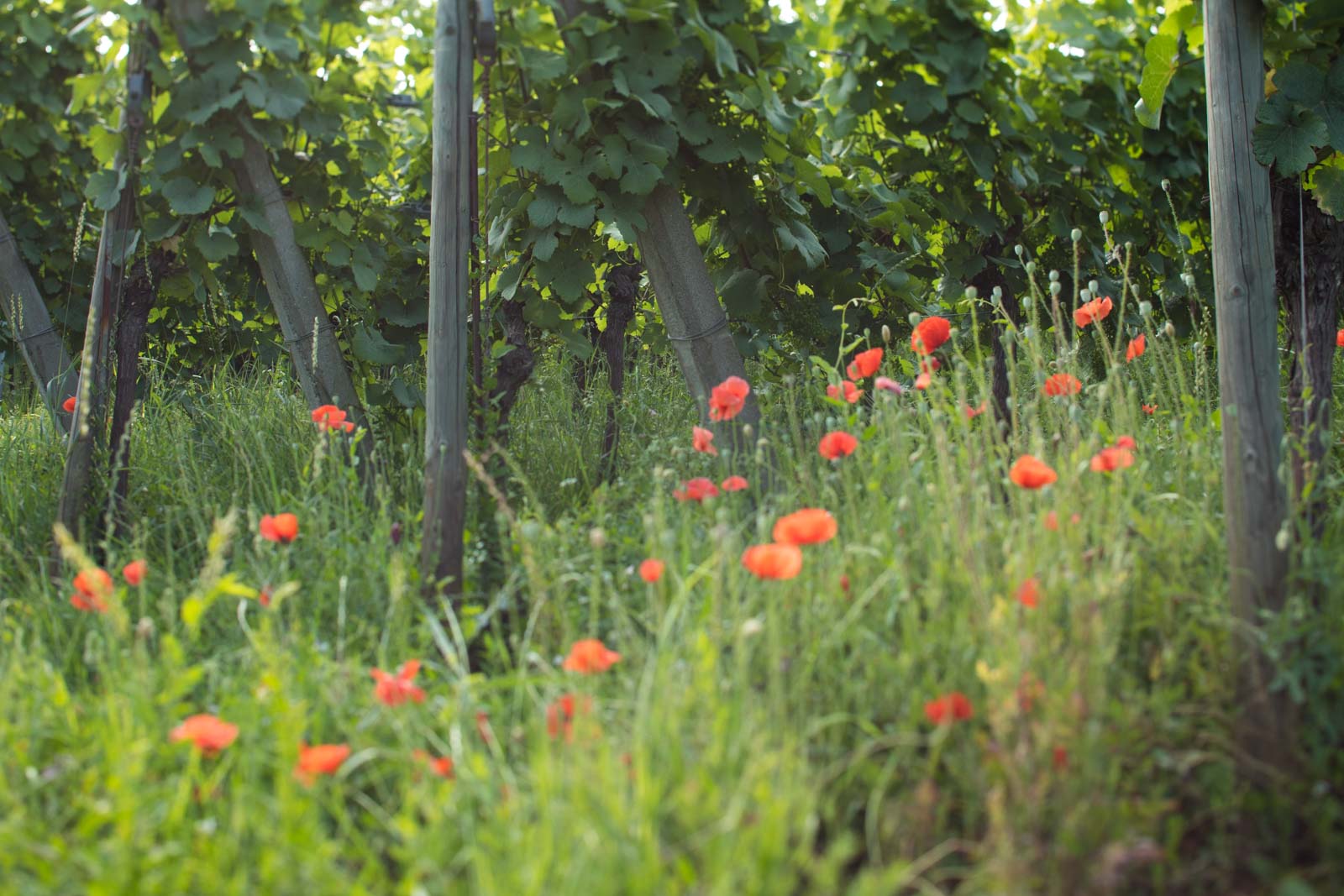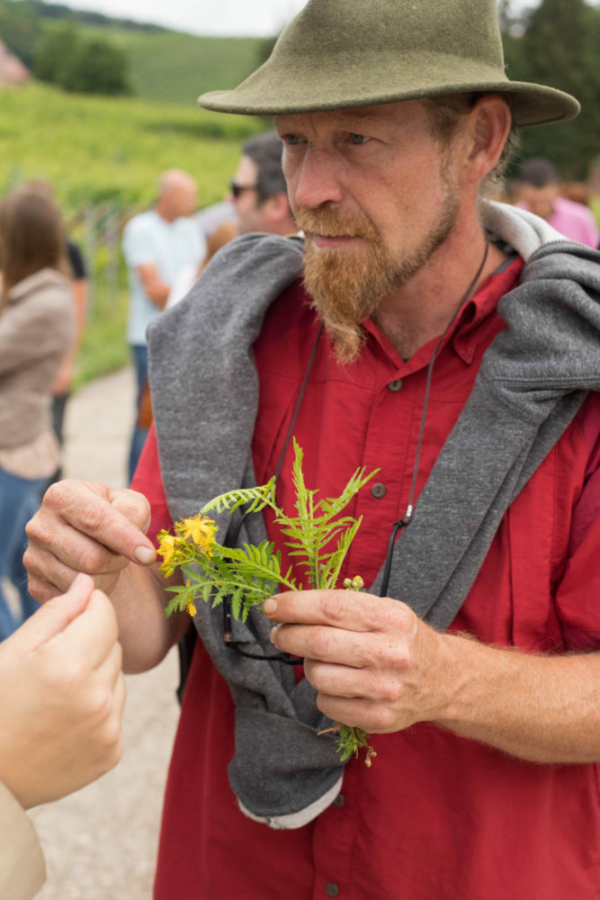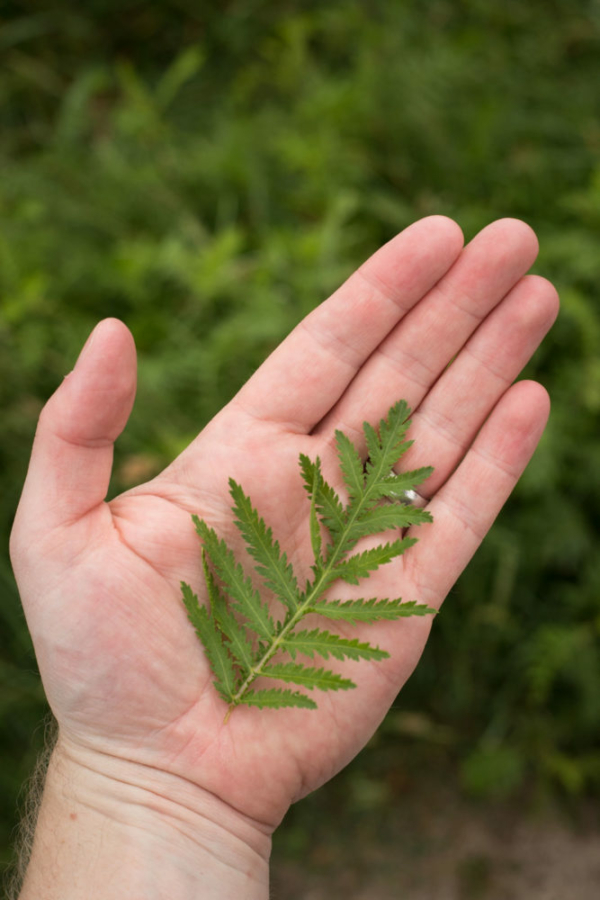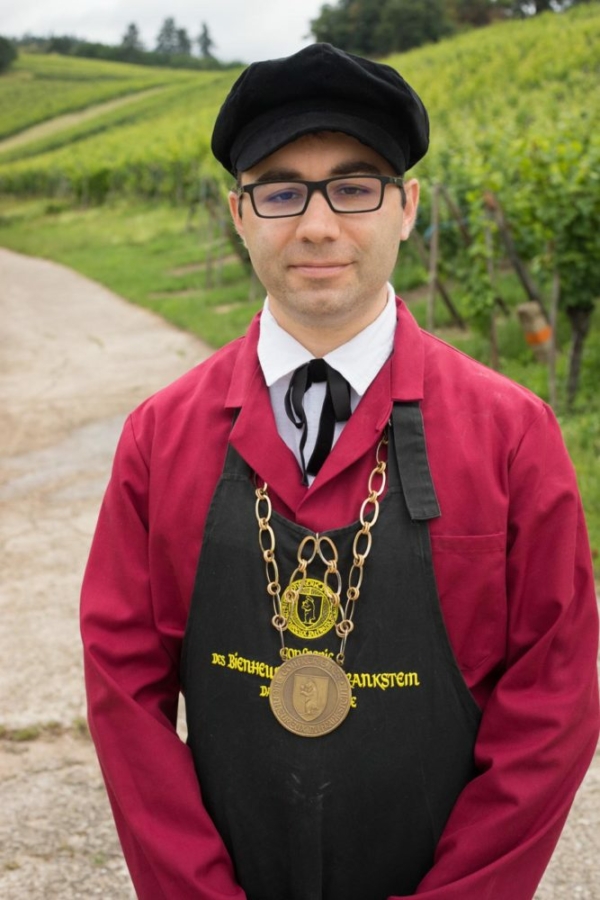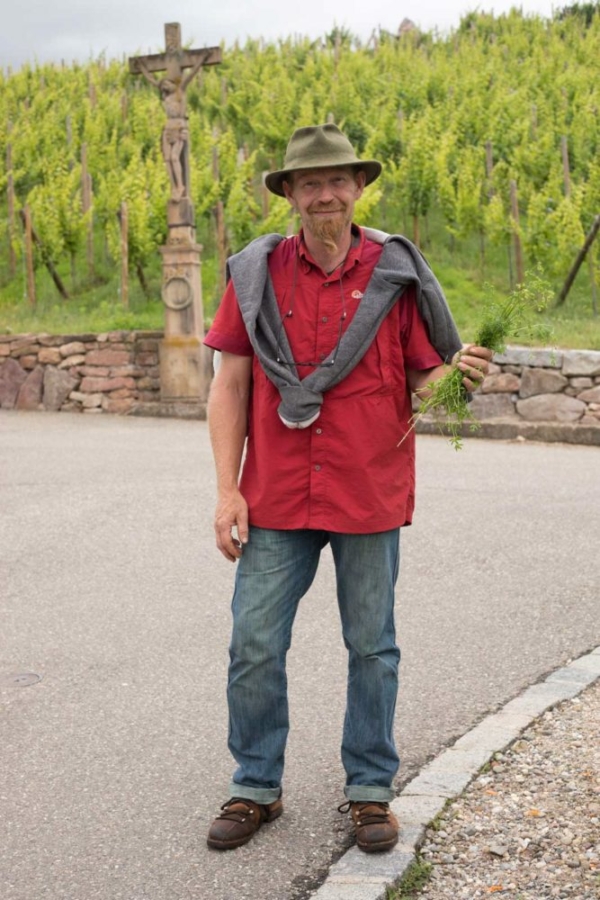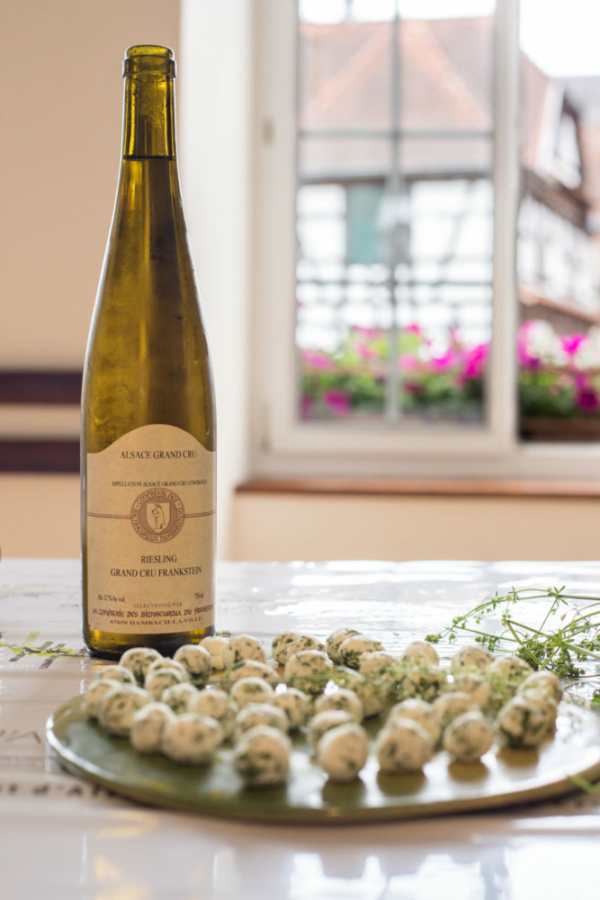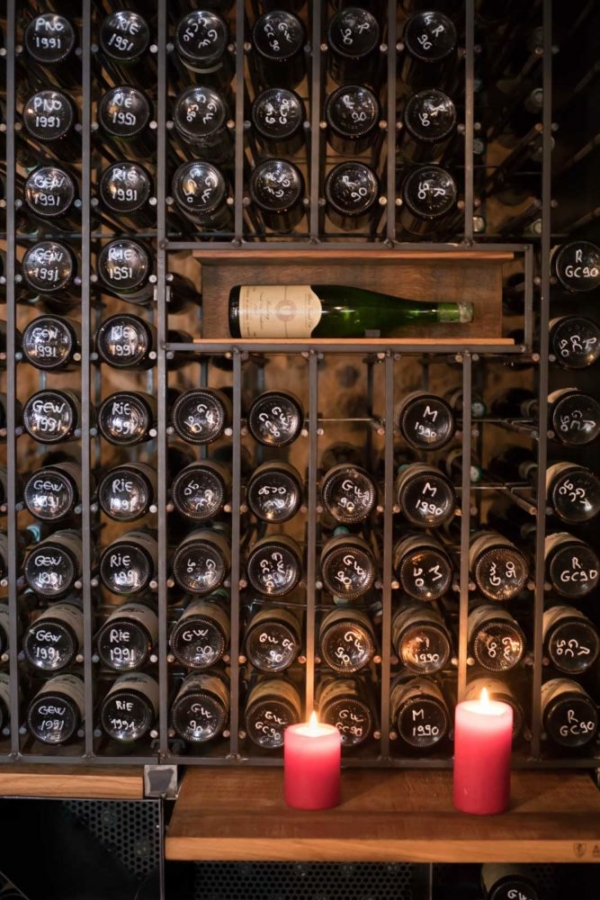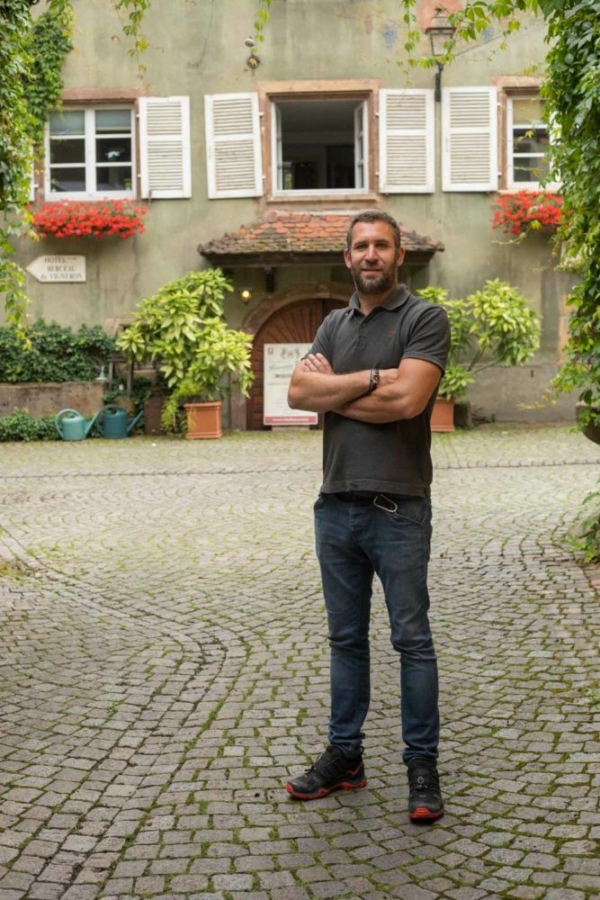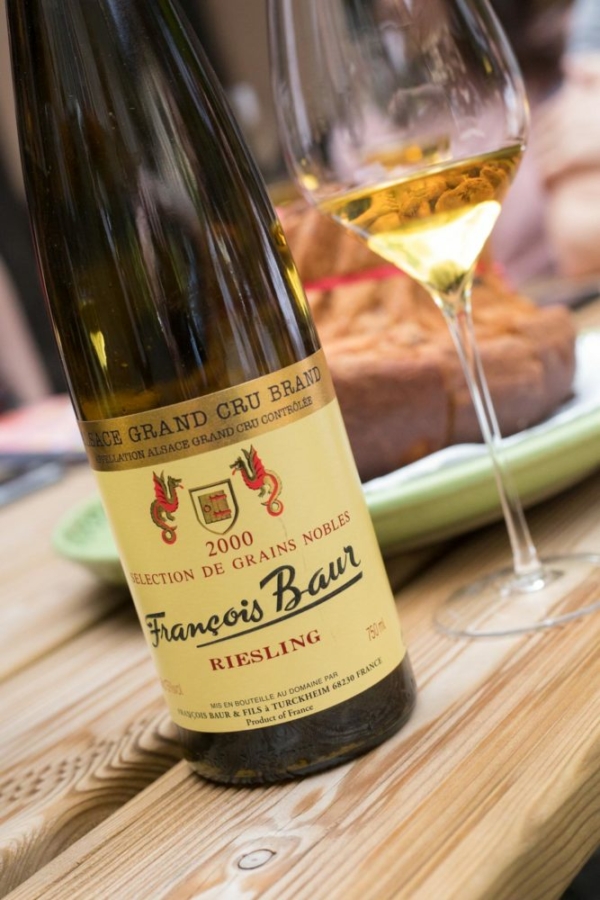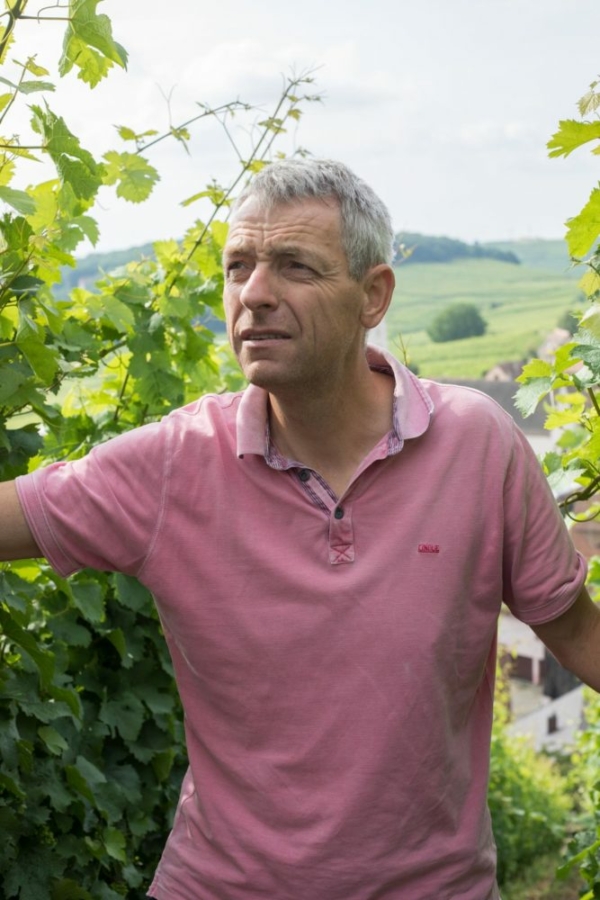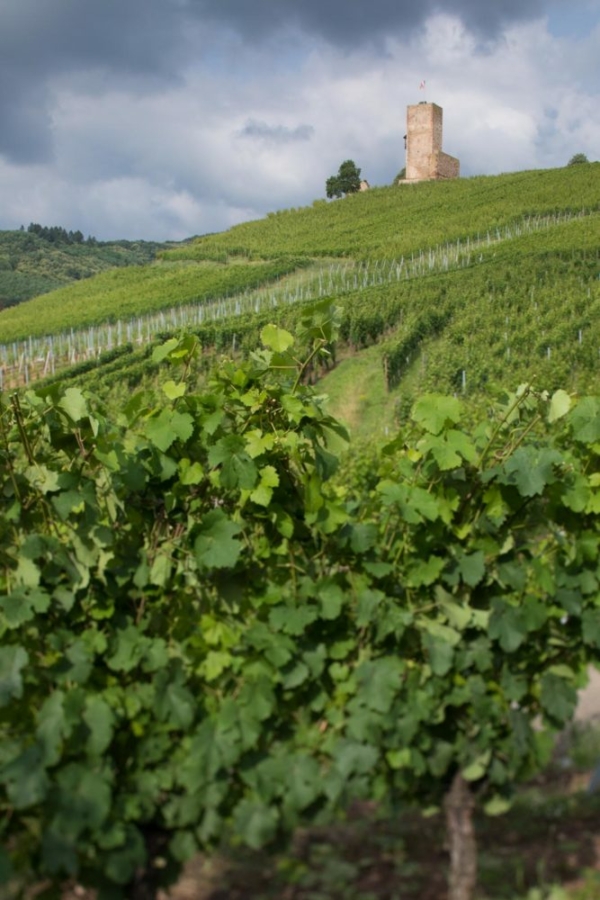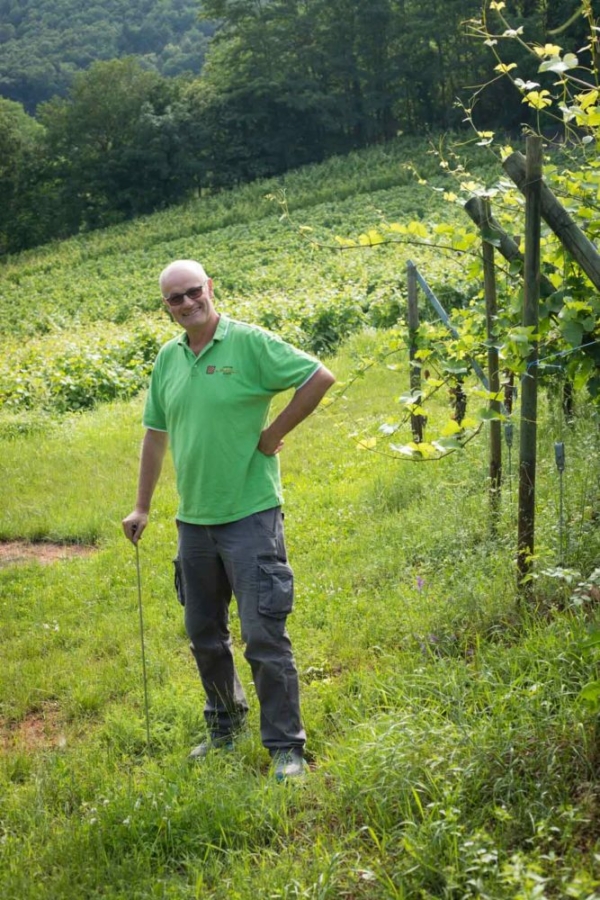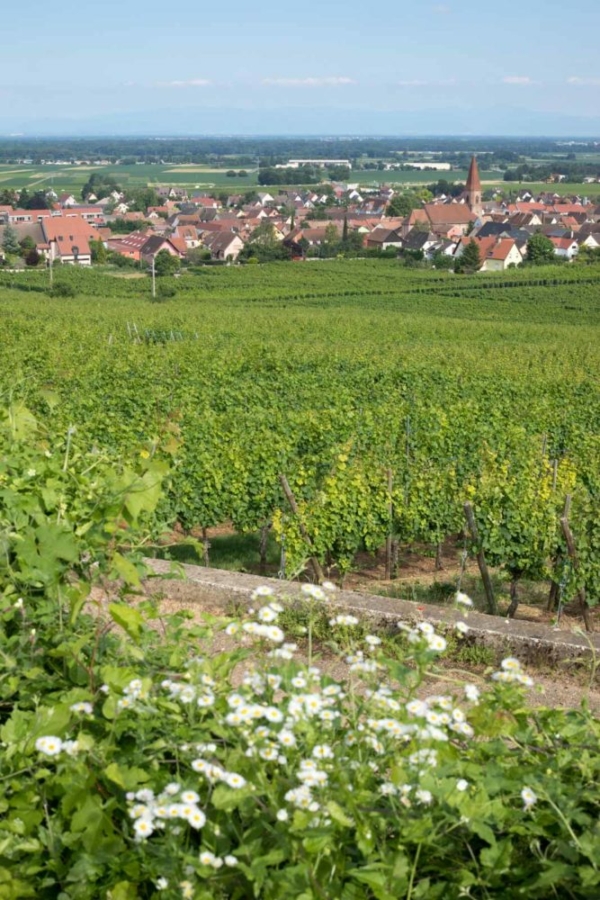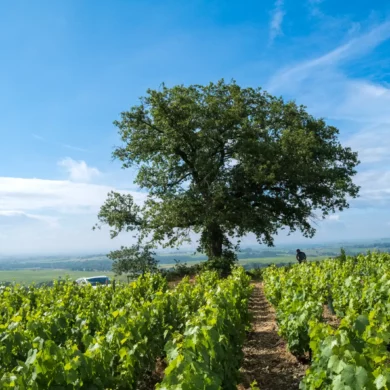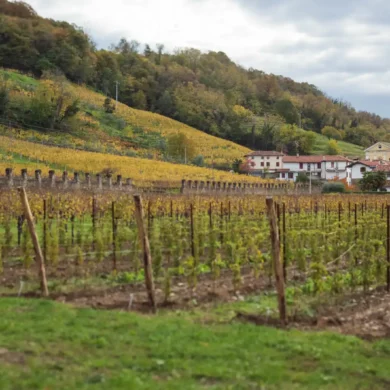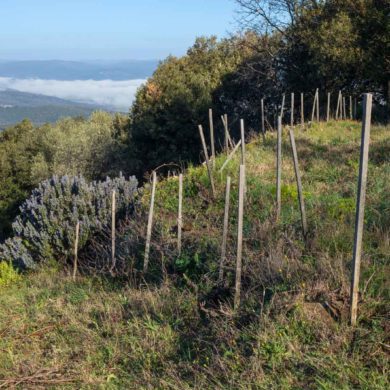At Domaine Albert Mann in the heart of France’s Alsace region, winemaker Maurice Barthelmé seems a little rushed. He is trying to accommodate my group’s tight schedule, yet still showcase his expansive range of wines. But our unionized French driver just keeps interrupting us, threatening to cut the day off at 5:30pm. He has somewhere to be.
But I can’t help it. I make a request: “can we see one of your vineyards?”
In an instant, Maurice’s demeanor changes. “Yes!” he says. “I can drive you.” He becomes more boyish and excited as he gathers his things, including a long metal rod. Suddenly, he is having fun. He is relaxed.
As for our driver with a 5:30pm deadline … “Who cares?” seems to be the prevailing attitude.
We are taken to the Grand Cru Hengst just above town, a celebrated vineyard whose name means “stallion” because of the powerful wines that come from its grapes. Maurice sinks the metal rod into various parts of the soil to show its varying degrees of depth. He picks up crumbled bits of clay here, sandstone there, demonstrating the typical chaos of Alsace’s soils. (They love their rocks here in Alsace).
But personally, I can’t get over the greenery. The Grand Cru Hengst is the last of eight vineyards I have walked through in my week’s time in Alsace. Every one of them has been bursting with a tapestry of grasses, wild herbs and flowers. Whether the winegrowers are practicing organic or biodynamic viticulture (or both), the prevailing ethos in Alsace’s top vineyards seems to be pretty simple: harmony with nature. “Sustainability” — that buzzword we often hear but rarely see — is actually before my very eyes this time.
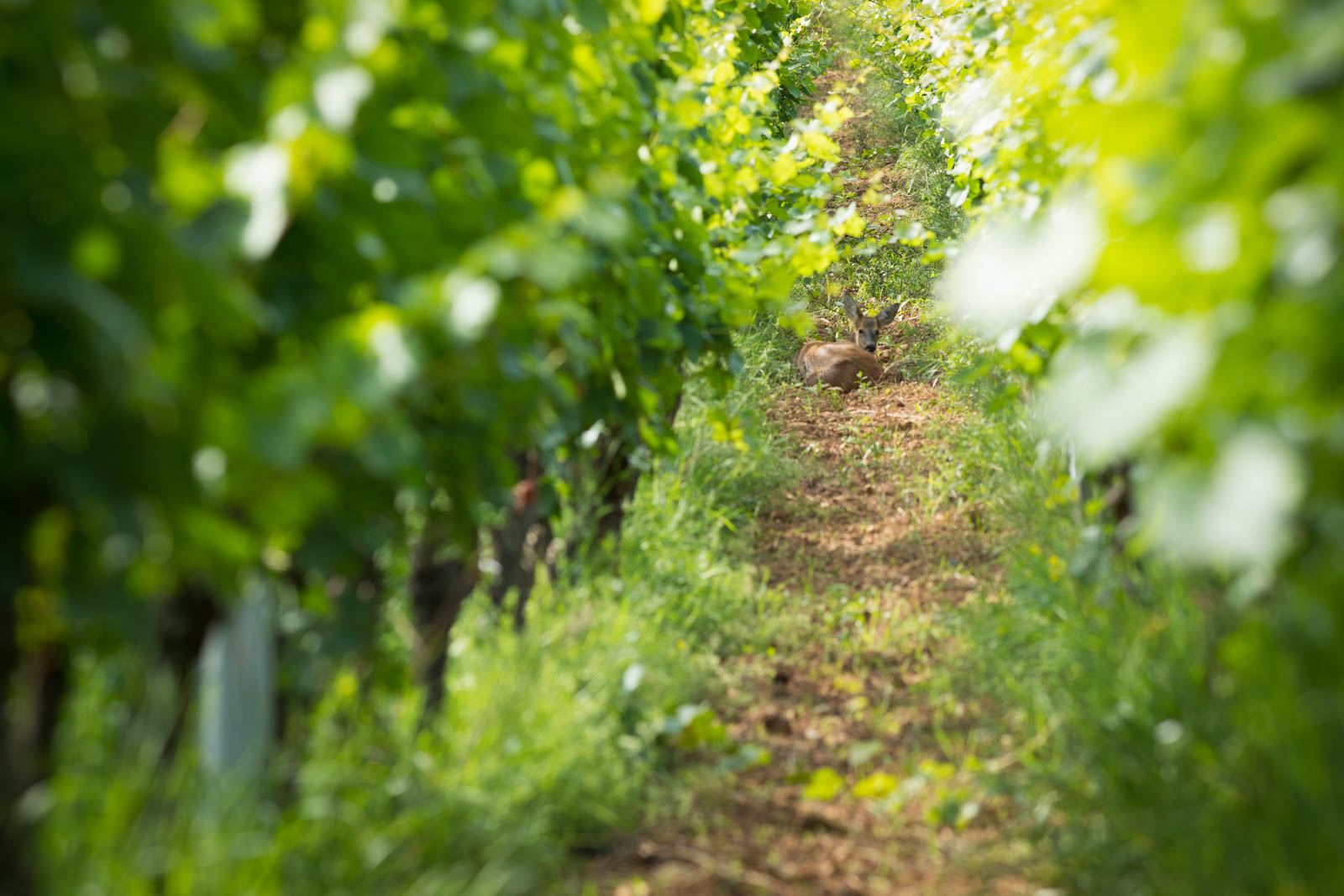
As if to demonstrate this, a doe suddenly appears in the vine rows of the Grand Cru Hengst. “Do you have to put up netting to prevent the deer from eating the grapes?” I ask.
Maurice bristles. “No. Why would we do that?”
Let’s Talk Natural, Shall We?
In many of the world’s great wine regions — Alsace included — natural winemaking has moved to the forefront. The term is nebulous at best, but the end goal is to create wines with the least amount of artificial intervention as possible, both in the vineyard and in the winery. (The practice isn’t new. Calling it “a movement” is).
At a distance, natural winemaking is admirable, yielding wines with a wide swing of aroma, flavor, texture and appearance that — one can assume — reflects the unvarnished outcomes of nature. I’ve had natural wines of stunning complexity and beauty. I’ve also had others that smell like liquid horse shit because of uncontrolled brettanomyces. (“Brett,” as it is called, is catnip to some. It’s a mood killer for me). Natural wine has divided wine drinkers, and like so many divisive things these days, the topic has become as contentious as primetime CNN. Just consult Twitter. (On second thought, don’t.)
I have no desire to participate in the yelling. I do believe strongly in sustainable agriculture. I also believe that if a winery is using chemicals, we should know about it.
But I also don’t want liquid horse shit. Or to discover that my favorite wine last year is completely different this year. It’s a complex subject and I have yet to place myself on the continuum of “for” or “against.” I guess I’m gray.
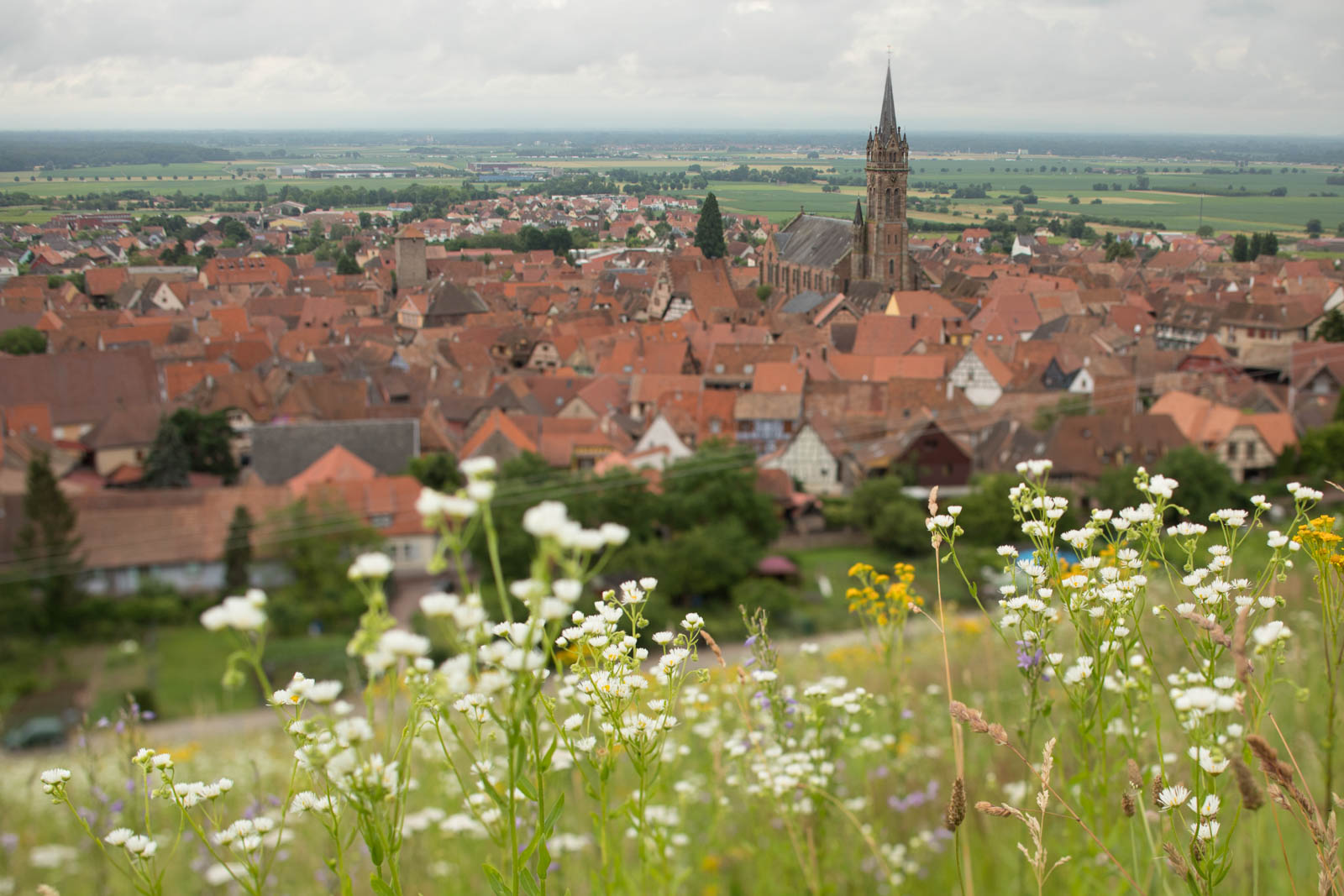
However, in Alsace, I found myself becoming an evangelist for a crucial aspect of natural wine — organic viticulture. That’s because my perspective on what makes a vineyard interesting and full of character was altered by several of Alsace’s Grand Cru. From the Kirchberg de Barr in the north to the Pfingstberg in the south, these vineyards were wild places yielding wild wines. There was nothing conventional about the way they looked, about the way they were managed, and most importantly, about the wines they yielded.
Come for the Grapes, Stay for the Herbs
The Grand Cru Frankstein sits above the beautiful, stork-laden village of Dambach-la-Ville. It was there that my group met the Confrérie des Bienheureux du Frankstein, a guild of winegrowers who tend to their hometown vineyard. “The Brotherhood,” as it was referred to, has been formally collaborating on the care of this expansive vineyard since 1990. Their priority is organic viticulture, and to showcase this, we went for a nature walk.
I was struck not only by how young the winemakers of the guild were (most were in their 20s and early 30s), but by how eager they were to show us the plants growing in the Grand Cru Frankstein that weren’t vitis vinifera. Obviously, the vineyard’s primary purpose is grapes. However, a variety of edible grasses, herbs and weeds are allowed to flourish because they serve as a Rosetta stone for the ecosystem’s health.
For instance, certain leafy plants only grow when there is soil compaction. Others, like sorrel, indicate a high level of acidity in the soil, which can then provide further clues about the microbial ecosystem underground.
“The sorrel has a fresh taste that jumps on the tongue,” noted winemaker Florian Beck-Hartweg. “And it is very close to the impressions you have in the wines from the granitic soils of the Grand Cru Frankstein.”
These clues, according to the winegrowers, lead to better management of the Pinot Gris, Riesling and Gewurztraminer growing in the Grand Cru Frankstein, because each grape thrives in different conditions.
In many conventional vineyards, these plants would have been obliterated by chemicals. Instead, we were not only picking and smelling them, we were eating them, too. A local forager named Jean-François Doussard had joined us for the walk. After a few minutes of foraging for us, his spectacles — which hung from his neck — were covered in pollen and plant bits. Later, we ate tapas he had prepared from plants picked in the vineyard, including bite-sized cheeses infused with hay to pair with the brotherhood’s signature Pinot Gris, and sausage marinated in pine nettle jus to partner with the Gewurztraminer.
A Taste of Terroir
Built in 1323, the tower of Dambach-la-Ville is one of the few in Alsace to survive World War II. (As the Germans retreated, snipers took to the towers to make a final stand, making the village towers a priority target for Allied artillery and bombers.) Underneath the village lies the wine cellar of the Confrérie des Bienheureux du Frankstein, and en route to the tasting, that’s where we stopped to pick up some wine.
After each vintage, the guild conducts a blind tasting of the many Riesling, Pinot Gris and Gewurztraminer produced from the Grand Cru. The wines that score the highest for each grape earn quite the prize: a small allotment is bottled and labeled separately as “Sélectionné par Confrérie des Bienheureux du Frankstein” for the express purpose of aging in the guild’s cellar.
We were treated to three of these wines with Jean-François’ tapas: the 2008 Riesling as well as the Pinot Gris and Gewurztraminer from 2016.
The Riesling had one foot in spring and another foot in autumn, conveying aromas that were vegetal and floral, as well as shades of apple cider and autumn leaves. The Pinot Gris was pure joy, with a fruity and floral bouquet. Meanwhile, the Gewurztraminer — a variety not known for its subtlety — whispered little bits of zest on the palate. It was likely the most reserved Gewurztraminer I have ever tasted.
Whether these qualities were evidence of the let-it-all-grow approach in the vineyard or not, I couldn’t say. But they were certainly speaking of terroir, the often-discussed, often-elusive French concept that a wine can describe its origins to you through subtle clues bestowed from climate and soil. They were among the wildest and most memorable wines I sampled in Alsace.
No Other Way
Spend a few days in Alsace and the notion that organic winemaking is “a movement” here becomes a bit silly. They have been doing it this way for a while, and the heated discussions of absolutism in natural wine consumption are thankfully a world away.
Yet Alsace has been making the case for organic viticulture for years. As of 2016, about 15 percent of the region’s vineyards are certified organic or biodynamic — among the highest in Europe. Organic viticulture is a good fit here partly because the Alsatian climate — continental, warm, dry — makes it easier to adopt. But winemakers also have a long enough track-record to know its impact on the product.
At François Baur in the village of Turckheim, winemaker Thomas Baur admitted he never learned any other way to manage the vineyards. “I never worked in chemicals … I don’t even know how” he added with a laugh.
His first vintage in charge was in 2009, some 11 years after his father had converted the estate to organics, and eight years after they had been certified biodynamic. But to this day, Thomas can tell the difference in the wines when he revisits older vintages, particularly those after 2001 when they converted to biodynamics.
“The wines have more volume, are deeper, and more concentrated,” he told me. “Yet very delicate. Those before? Not so much.”
His father’s decision was largely fueled by a desire to not expose himself or his family to chemicals. It was a “way of life” change as much as anything, according to Thomas.
Unexpected Benefits
In fact, this chorus was echoed nearly everywhere I went: at Specht, Camille Braun, Charles Baur and Pierre Meyer. It seemed as though organic viticulture — at least in the Grand Cru vineyards — was a way of life. They’d politely answer questions about it, but it wasn’t the main thing they wanted to talk about. It’s not that the winemakers were reticent to discuss the practice’s merits; it was just old news to them. They wanted to zero in on the wine and talk terroir.
Yet I kept finding areas where the merits of organics were surprising and unexpected. At Meyer-Fonné in Katzenthal — a practicing organic estate which produces Riesling and Pinot Noir of sublime texture — organic practices toward cover crops in the vineyard were literally keeping the hillside intact.
We started the tour in the Grand Cru Wineck-Schlossberg that rises dramatically above the village of Katzenthal. Green and amber grasses and little white flowers on stalks permeated the understory of the vines, helping — in their own small way — with erosion control.
A downpour overnight had laid bare the contrast. Toward the bottom of the vineyard, where very young vines had been planted, the gravelly topsoil had washed away and belched out onto the road.
“This …” Felix noted, pointing at the mess “is not so good, but it will be OK.” He explained that grass and new vines compete for nutrients too much. So, the winegrowers till the soil to prevent plant growth until the vines are mature enough. “Next year, in its third year, the winemaker will grow plants…” and in turn, help preserve the hillside through a broader network of roots.
If there is an ethos to the management of Alsace’s Grand Cru vineyards, it is that nature already holds the answers to keep the vines healthy.
Sleeping Out Under the Stars
Back in the Grand Cru Hengst, Maurice presses his luck with our driver further: he wants to show us the “soon-to-be premier cru” vineyard of Les Saintes Claires nearby. (There is a proposal to institute a new layer of vineyard classifications across Alsace — a second tier of Premier Cru — so at the moment, it seems, every winemaker is proclaiming their non-Grand Cru vineyards as such).
Maurice giddily shares more soil samples and provides a demonstration on training the eager summer vines. “But we really need to go,” our group organizer finally says, reluctantly. I’ve noticed that she has been looking at her cell phone, reading the angry texts from the driver we left back at the winery.
As we return to Maurice’s car, he taps my shoulder. “Let me show you one more thing. Come along.”
He takes off in a run up the vine row that separates Les Saintes Claires and the Grand Cru Hengst, thick grass and white flowers underfoot. I follow, and he leads me around a bend to a large tree where an escarpment of sandstone reveals a story of terroir I’m unqualified to read. A songbird is warbling happily nearby. And then Maurice — reading on my face that I, too, am a nature boy — tells me one more thing.
“I like to come out here and sleep under this tree and look at the stars. The deer wakes me. She licks my forehead and I awake.”
Whether this story transpires every new moon or just happened one time, I do not ask. I do not need to. It punctuates a theme I’d seen all week in Alsace: an affection for nature that goes beyond wine.
Essential Winemakers
The wines of each winemaker mentioned in this article are worth seeking out, but in particular, the wines of Domaine Albert Mann and Domaine François Baur. Both are included in my curated list of Essential Winemakers of France.
Note: My travels to Alsace were funded by Vins Alsace who invited me as one of a select group of American journalists to cover their bi-annual Millesimes d’Alsace event. Learn more about my editorial policy.
